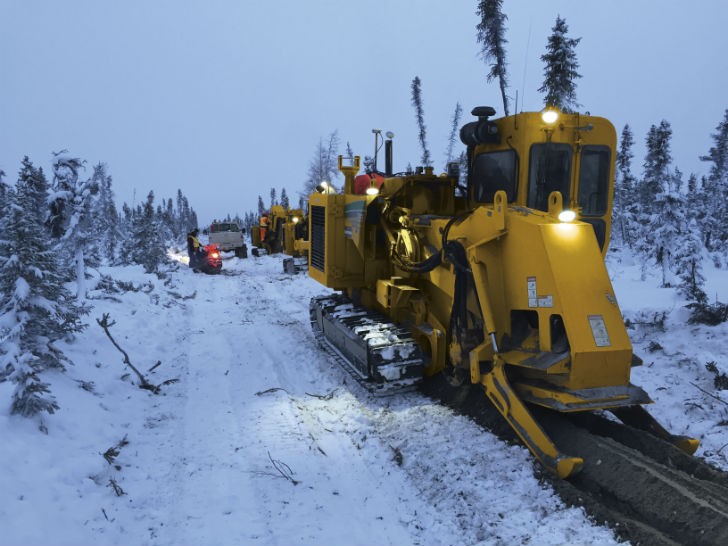Trenching Above the Arctic Circle
Temperatures to minus 50, days with little sunlight, frozen permafrost – just part of the job

Rohl Enterprises is dealing with challenging soil conditions, extreme weather, an isolated jobsite, special environmental considerations – and more – during a two-year fibreoptic installation in northern Canada that extends above the Arctic Circle. Not that it bothers the company.
“We like the big, challenging projects, which a lot of people try to steer away from,” said owner Jason Rohl. “We always do it on time, and we do it on budget – and even crazier, we enjoy it.”
The Mackenzie Valley Fibre Link project meets that standard in spades. The objective is to install approximately 1,200 km of fibre, mostly with open-cut methods, on a route running north to south in the Northwest Territories.
When work started in mid-January, the sun was out for just a couple of hours each day and crews were working in temperatures that were regularly minus 34° C and lower. The soil conditions included permafrost, which is ground that is frozen year round and is protected by the government.
The end result will be a fibre-optic line that brings high-speed Internet and improved telecommunications to several communities in a remote region.
The Northwest Territories is vast at 1,346,105 square km. It is also sparsely populated, with 43,485 residents as of 2011.
“The fibre project brings these communities into the 21st century as far as telecommunications infrastructure goes,” said Sean Craig, an analyst with the Finance Department of the Government of the Northwest Territories. “The communities up in the Mackenzie Valley are either on a microwave radio system or on satellite. So fibre optics, it’s hard to put into words just how much better that is.”
The Government of the Northwest Territories, which is funding the $82 million project, says the faster Internet speeds could lead to new business opportunities, the expansion of an international satellite station and more effective government services, including tele-health and education. There is a lack of medical specialists in the Mackenzie Valley, and the fibre-optic line will allow for better transmission of data, such as lab results and X-rays, and consultations with physicians in larger towns. Similarly, e-learning and distance education will be improved.
“They’re very small communities, they’re extremely remote, and they’re only accessible by winter road, plane or the barge down the river,” Craig said.
A natural fit for the job
Manitoba-based Rohl Enterprises was a natural fit for the Mackenzie Valley project as several years ago the company installed what is, for now, the northernmost fibre line in the Northwest Territories.
The company began operations in the 1960s and focused on transmission line clearing until transitioning into road building in the 1980s. In 1987 it switched to telecommunications work, and in 1994 it added natural gas. Telecom now makes up about 80 percent of its business.
Rohl Enterprises provides turnkey services, performing the design, engineering and installation work for most of its projects.
For the Mackenzie Valley project, however, it is solely serving as the installer. The project is being led by a consortium made up of Ledcor Developments, a Vancouver- based construction company, and Northwestel, a Canadian telecommunications company. The Government of the Northwest Territories is the project owner.
The project involved several years of study and planning. Work started in January in the town of Inuvik, which is the northernmost point on the fibre line and above the Arctic Circle. For the groundbreaking ceremony on the frozen permafrost, a Vermeer T555 Commander 3 tractor with a rockwheel attachment did the honour.
That is one of eight pieces of Vermeer equipment Rohl Enterprises ordered specifically for the project. There were two more T555s with rockwheels, two T655 Commander 3 tractors with rockwheels, an RTX1250 ride-on tractor with a rockwheel, another RTX1250 but with a vibratory plow, and an RTX550 ride-on tractor with a vibratory plow.
Rohl Enterprises has very specific needs for the project. The work in the north must occur in the winter because the ground has to be frozen enough and have a certain amount of snow on it to protect it from and support the construction equipment. Rohl said he needed solid, reputable machines but they couldn’t be too heavy.
Rohl Enterprises would normally use a cable plow instead of rockwheels but plowing causes more surface disruption and the government wants as little of the permafrost touched as possible.
Rohl also needed the equipment delivered quickly. “To phone and say that I want six rockwheels by Christmas when you give them a couple of months’ notice, most people would simply either lie to you or hang up on you,” Rohl said. “But Vermeer produced on schedule and actually enhanced on it. It was remarkable.”
The project is to be completed in April 2016 but will occur in phases because of the winter-work requirements. The winter season runs until early April. Rohl Enterprises will work on the south section in the warmer months and then it will start up again in the north next January.
So while it may seem counterintuitive to those who work in warmer climates, trenching crews started on the northern section of the line in the heart of winter. Six crews were deployed, each led by a track trencher with a rockwheel. Three started in Inuvik and three near Norman Wells, a community near the middle of the fibre-optic line.
The half-inch (12.7 mm) fibre cable was installed between 46 and 61 cm below ground mostly in the right of way of a highway and a winter road. The trench width was 4 inches (10.2 cm), as narrow as feasible so as to protect the permafrost. The plow attachments were used to place the fibre in the trench.
In the north, the ground was solid permafrost. Around Norman Wells, the permafrost came and went. Other ground conditions included rock, boulders, clay, frozen sands, frozen aggregate and frozen peat moss. “When dealing with a job 746 miles (1,200 km) in length, we are going to hit everything known to man,” Rohl said.
The one constant was the cold. Temperatures reached as low as minus 50 degrees Celsius.
Rohl said that being a Canadian company, his crews weren’t terribly bothered by the cold. Keeping busy and wearing the proper gear were the best ways to keep warm.
Equipment maintenance becomes extra important in such low temperatures. Add to that the hard ground and Rohl Enterprises decided to hire three service technicians from Vermeer Canada to keep the machines in peak condition.
The Vermeer equipment handled the frozen ground better than Rohl anticipated and by early March his crews where installing about 10 km of fibre a day. “The equipment has made me as productive as I could be, without a doubt,” he said.
Night can be a relative term so far north. When fibre installation started, there were only a couple hours of sunlight each day starting at about noon. Vitamin D supplements and counselling were available to workers to combat the low sun exposure, and crew had light towers, head lamps and flashlights. The dark never became a problem, Rohl said.
Not your normal logistics
The crews working the farthest north lived in mobile camps moved on sleigh mounted trailers. None of the waste from man or machine was to touch the ground.
“It is a task in itself when you are talking about being 100 km in the middle of the tundra,” Rohl said. “It’s so remote it’s tough to even fathom what I am talking about when I say we have to haul out gray water and haul in fresh water and you have a 22-man camp.”
Environmental monitors followed every crew watching for everything from camp waste to at-risk wildlife, which if spotted could require a work stoppage to let them pass.
Crews were restricted to a right of way of six metres. They could double the width every five km to use as a passing zone and staging area.
Rohl said that moving equipment and supplies took a great deal of planning and coordination but his company is becoming well versed in jobs with complex tasks like this.
“The projects have gotten bigger and more remote,” Rohl said. “We just take what we’ve learned and apply it to the current job, and learn a little bit more and keep getting better.”



